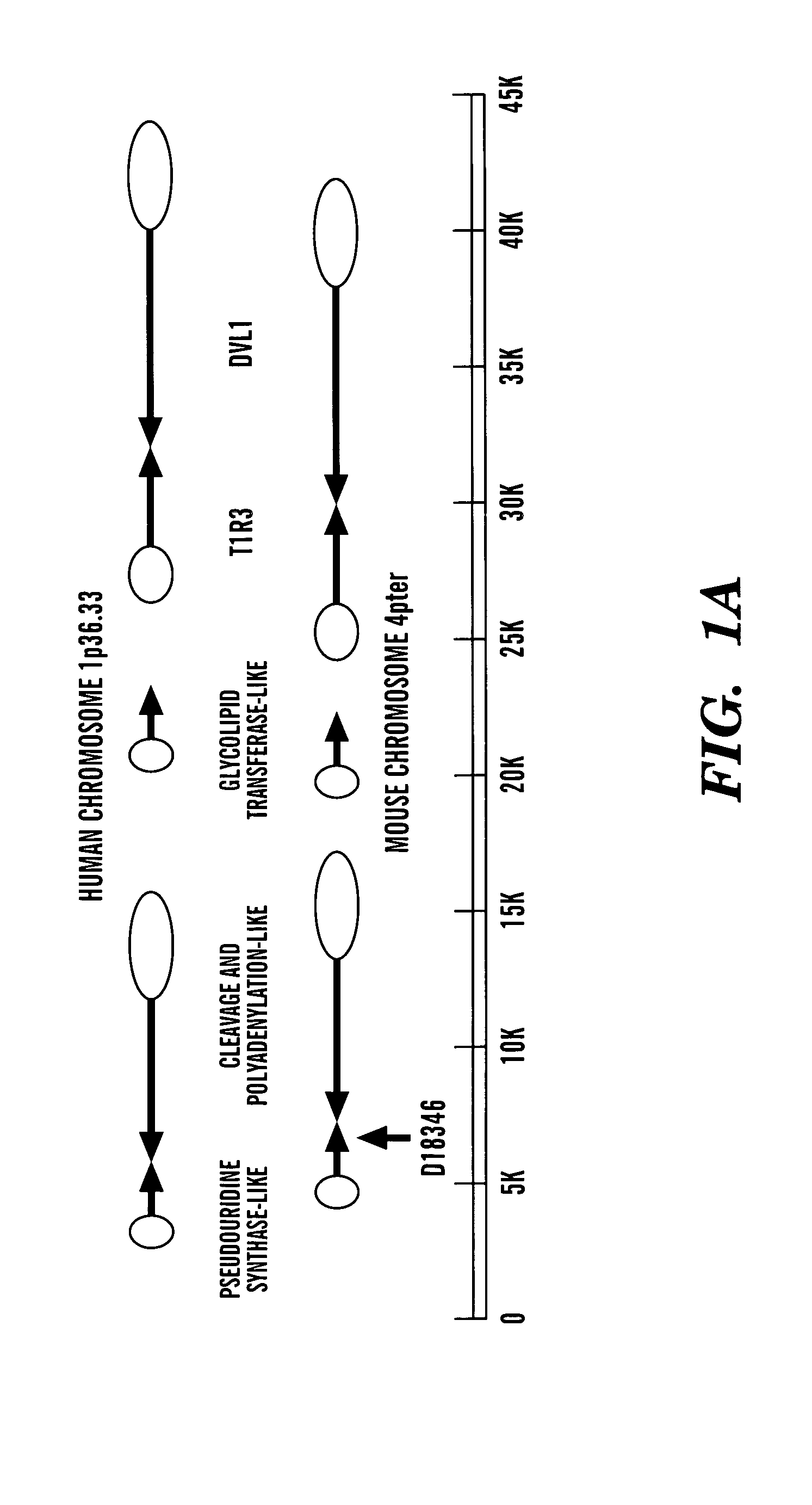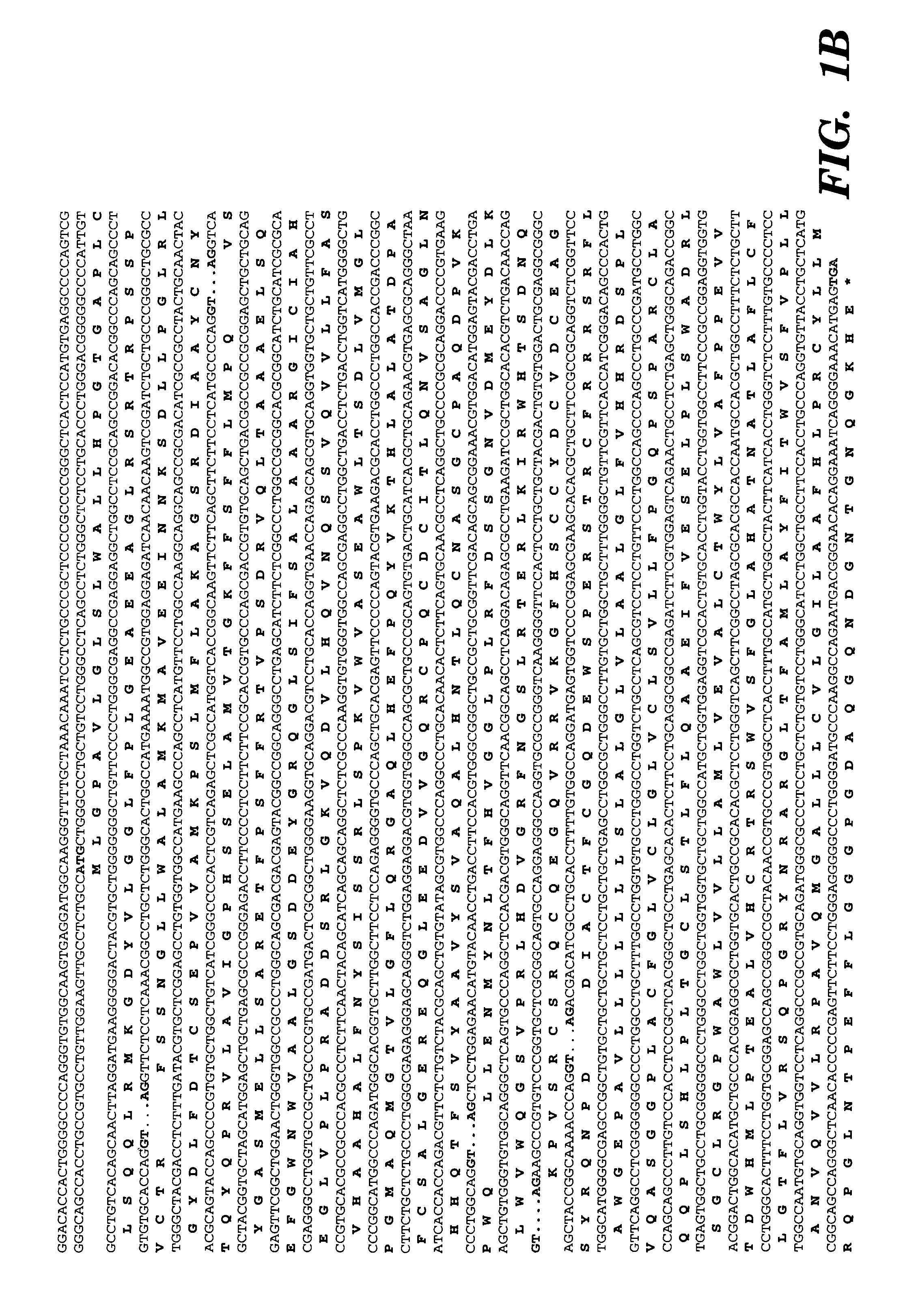T1R3 transgenic animals, cells and related methods
- Summary
- Abstract
- Description
- Claims
- Application Information
AI Technical Summary
Benefits of technology
Problems solved by technology
Method used
Image
Examples
example
Cloning and Characterization of the T1R3 Gene
[0270] The data presented below describes the identification of a novel taste receptor, T1R3, as being Sac. This identification is based on the following observations. T1R3 is the only GPCR present in a 1 million bp region of human genomic DNA centered on the D18346 marker most tightly linked to Sac. Expression of T1R3 is narrowly restricted and is highly expressed in a subset of taste receptor cells. Expression of T1R3 in taste receptor cells overlaps in large part with known and proposed elements of sweet transduction pathways (i.e. α-gustducin, Gγl3. T1R3 is a family 3 GPCR with a large extracellular domain sensitive to proteases (a known property of the sweet receptor). Most tellingly, a polymorphism in TlR-3 was identified that differentiated all taster strains of mice from all non-taster strains: T1R3 from non-tasters is predicted to contain an N-terminal glycosylation site that based on modeling of T1R3's structure would be expect...
example 2
Method Used to Produce Transgenic Mice
[0294] Knock-out mice lacking the entire T1R3 coding region were produced by homologous recombination in C57BL6 (B6) embryonic stem (ES) cells, followed by injection of the targeted stem cells into blastocysts (see FIG. 10).
[0295] A B6 mouse BAC library was screened with a PCR-amplified T1R3 DNA probe having the following nucleotide sequence:
A CAGCAATTCA AGGCACAAGG GGACTACATA CTGGGCGGGCTATTTCCCCT GGGCTCAACC GAGGAGGCCA CTCTCAACCA GAGAACACAACCCAACAGCA TCCCGTGCAA CAGGTATGGA GGCTAGTAGC TGGGGTGGGAGTGAACCGAA GCTTGGCAGC TTTGGCTCCG TGGTACTACC AATCTGGGAAGAGGTGGTGA TCAGTTTCCA TGTGGCCTCA GGTTCTCACC CCTTGGTTTGTTCCTGGCCA TGGCTATGAA GATGGCTGTG GAGGAGATCA ACAATGGATCTGCCTTGCTC CCTGGGCTGC GGCTGGGCTA TGACCTATTT GACACATGCTCCGAGCCAGT GGTCACCATG AAATCCAGTC TCATGTTCCT GGCCAAGGTGGGCAGTCAAA GCATTGCTGC CTACTGCAAC TACACACAGT ACCAACCCCGTGTGCTGGCT GTCATCGGCC CCCACTCATC AGAGCTTGCC CT
A commercial service (IncyteGenomics) performed the screen. Three BAC clones c...
example 3
Characterization of T1R3 Knock-Out and Wild-Type Mice Using Behavioral Tests
[0306] Behavioral tests were conducted to examine the responses of T1R3 knock-out mice to tastants representing five taste qualities (sweet, bitter, salty, sour and umami). Mice of both sexes aged between 2 and 12 months were used. Age- and gender-matched mice were used in the three genotype groups, and littermates were used in the knock-out and B6 wild-type control groups. The two-bottle preference test consisted of giving the mice two bottles, one containing deionized water and the other a tastant solution, for 48 hours. The bottle positions were swapped after 24 hours to eliminate position effects. The ratio of tastant to total liquid consumed was measured and compared between groups using known methods (see, e.g., Wong, G. T. et al., Nature, 381: 796 (1996).
[0307] The tastants were presented at two-fold or three-fold ascending concentrations. The mice were allowed a 7-day recovery period with deionized...
PUM
 Login to View More
Login to View More Abstract
Description
Claims
Application Information
 Login to View More
Login to View More - R&D
- Intellectual Property
- Life Sciences
- Materials
- Tech Scout
- Unparalleled Data Quality
- Higher Quality Content
- 60% Fewer Hallucinations
Browse by: Latest US Patents, China's latest patents, Technical Efficacy Thesaurus, Application Domain, Technology Topic, Popular Technical Reports.
© 2025 PatSnap. All rights reserved.Legal|Privacy policy|Modern Slavery Act Transparency Statement|Sitemap|About US| Contact US: help@patsnap.com



